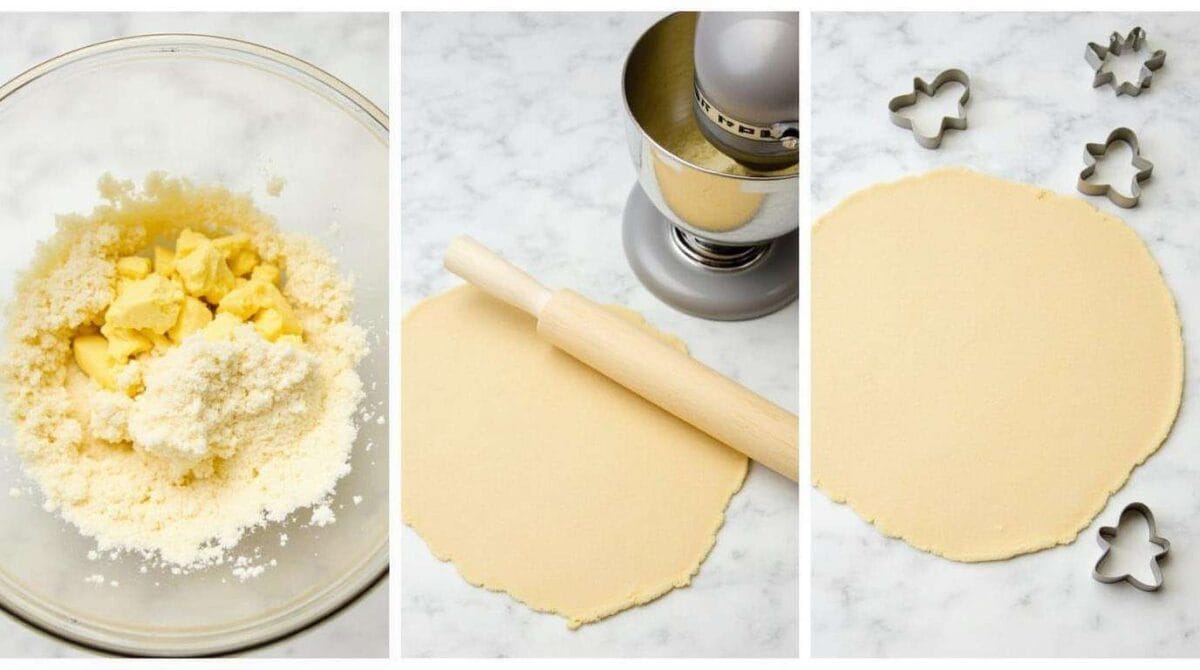Welcome to your one-stop guide to mastering the gluten-free sugar cookie recipe! Whether you’re a baking enthusiast or a newbie, this article will walk you through everything you need to know to create soft, chewy, and delicious gluten-free sugar cookies that are sure to impress. We’ll cover essential ingredients, tips, troubleshooting, and creative decorating ideas to make your cookies stand out. Let’s dive in!
Table of contents
What Are Gluten-Free Sugar Cookies?
Gluten-free sugar cookies are a delightful alternative to the traditional version, crafted without wheat or gluten-containing ingredients. These cookies are perfect for individuals with gluten intolerance, celiac disease, or those simply choosing a gluten-free lifestyle. Despite being free of gluten, they maintain the same tender texture and irresistible sweetness you’d expect from classic sugar cookies.
Why Go Gluten-Free?
Going gluten-free isn’t just for health reasons; it’s a creative and versatile way to bake. Gluten-free baking opens doors to unique ingredients like almond flour, coconut flour, and all-purpose gluten-free flour blends. Whether you’re catering to dietary restrictions or exploring new culinary adventures, these cookies are a must-try!
Benefits of Baking Gluten-Free Sugar Cookies
- Perfect for Everyone: These cookies are inclusive, allowing everyone at the table to enjoy a treat without worry.
- Creative Freedom: Experiment with diverse flours and mix-ins for fun flavor combinations.
- Easy and Quick: With the right recipe, gluten-free sugar cookies are just as simple to make as traditional ones.
Key Ingredients and Their Roles
Essential Ingredients for Gluten-Free Sugar Cookies
A successful gluten-free sugar cookie recipe starts with the right ingredients. Each component serves a specific purpose in delivering that soft, chewy texture and irresistible sweetness. Here’s a breakdown of the key players:
- All-Purpose Gluten-Free Flour Blend
The foundation of your cookies, this blend mimics traditional flour. Look for blends containing xanthan gum for structure. - Xanthan Gum
This is a game-changer in gluten-free baking. It binds the dough, replacing the elasticity provided by gluten. Without it, your cookies may crumble. - Granulated Sugar
It’s not just for sweetness—it also helps cookies spread evenly during baking. - Eggs
Acting as a binder, eggs provide structure while keeping your cookies moist. - Milk (or Non-Dairy Alternatives)
A small amount of liquid ensures the dough is easy to mix and roll out. Opt for almond or oat milk for dairy-free versions. - Butter or Shortening
These fats add flavor and give the cookies their tender crumb. Vegan alternatives like coconut oil work well too.
Customizing for Dietary Preferences
Want to adapt the recipe? No problem! Gluten-free sugar cookies are incredibly versatile:
- Low-Sugar Variations: Use coconut sugar or stevia for a lower glycemic option.
- Vegan Adaptations: Substitute eggs with a flaxseed meal mixture (1 tbsp flaxseed + 3 tbsp water per egg).
Equipment Needed for Perfect Sugar Cookies
Basic Baking Tools
To make your gluten-free sugar cookie recipe a breeze, you’ll need:
- Mixing Bowls: Use separate ones for wet and dry ingredients.
- Measuring Cups and Spoons: Accuracy is critical in gluten-free baking.
- Baking Sheets: Line them with parchment paper to prevent sticking.
Specialty Tools
Take your cookie game to the next level with these helpful extras:
- Rolling Pins: Dust with gluten-free flour for smooth rolling.
- Cookie Cutters: Perfect for creating holiday shapes or unique designs.
- Cooling Racks: Let cookies cool completely to avoid breaking.
Step-by-Step Guide to Making Gluten-Free Sugar Cookies

Creating the perfect gluten-free sugar cookie recipe doesn’t have to be intimidating. With this simple step-by-step guide, you’ll have soft and chewy cookies ready to impress in no time!
Preparing Your Ingredients
Before diving in, it’s essential to have all your ingredients prepped and ready:
- Measure your all-purpose gluten-free flour blend accurately. Scoop and level the flour instead of packing it to avoid a dense dough.
- Ensure your butter or shortening is at room temperature for smooth mixing.
- Preheat your oven to 375°F (190°C) to save time later.
Mixing and Shaping the Dough
- Combine Wet Ingredients
In a mixing bowl, cream the butter (or shortening) with granulated sugar until light and fluffy. Add the egg and vanilla extract, mixing until smooth. - Incorporate Dry Ingredients
Gradually add the gluten-free flour blend, xanthan gum, baking powder, and a pinch of salt to the wet mixture. Stir until just combined. Avoid overmixing as it can make the dough tough. - Chill the Dough
Roll the dough into a ball, wrap it in plastic, and refrigerate for at least 30 minutes. This step prevents the cookies from spreading too much during baking. - Shape the Cookies
Roll out the chilled dough between two pieces of parchment paper to your desired thickness. Use cookie cutters for fun shapes or a simple glass for round cookies.
Baking and Cooling
- Place the shaped cookies on a parchment-lined baking sheet, spacing them about 2 inches apart.
- Bake for 8-10 minutes or until the edges turn golden brown.
- Let the cookies cool on the baking sheet for 5 minutes before transferring them to a wire rack. This helps them firm up without breaking.
Frosting and Decorating Ideas

The beauty of a gluten-free sugar cookie recipe lies in its versatility, especially when it comes to frosting and decorating. Whether you prefer a classic look or a festive flair, the options are endless.
Types of Frosting
- Buttercream Frosting
A rich, creamy frosting made with butter, powdered sugar, and a splash of milk. It’s perfect for spreading or piping intricate designs. - Cream Cheese Frosting
For a tangy twist, use cream cheese as your frosting base. It pairs beautifully with the sweetness of the cookies. - Royal Icing
If you’re after a smooth, glossy finish, royal icing is your go-to. Made with egg whites and powdered sugar, it sets hard, making it ideal for detailed decorations.
Creative Decorating Techniques
- Holiday Themes
Use food coloring to tint your frosting for Christmas, Halloween, or Easter. Add sprinkles or edible glitter for extra pizzazz. - Minimalist Elegance
For a sophisticated touch, pipe simple patterns using white icing. Top with a sprinkle of sugar for sparkle. - Kid-Friendly Fun
Let the little ones unleash their creativity by providing a variety of sprinkles, colored icing, and edible markers.
Common Issues and Troubleshooting Tips
Even the best bakers encounter hiccups when making a gluten-free sugar cookie recipe. The good news? Most problems have simple fixes. Let’s tackle the most common issues and how to avoid them.
Why Is My Dough Too Sticky or Too Dry?
- Sticky Dough
If your dough feels sticky, it might be due to excess moisture or insufficient chilling time. To fix it, dust your rolling surface with a bit of gluten-free flour or refrigerate the dough longer.
Pro Tip: Humidity can affect dough consistency, so work in a cool, dry space whenever possible. - Dry or Crumbly Dough
This issue often arises from using too much flour or not enough liquid. Add a teaspoon of milk at a time and gently mix until the dough holds together.
Preventing Crumbling and Breakage
Gluten-free cookies are more delicate than their traditional counterparts. To keep them intact:
- Avoid overmixing the dough, which can weaken its structure.
- Let cookies cool completely on the baking sheet before transferring them.
Adjusting for Altitude or Humidity
- At higher altitudes, reduce the baking powder slightly and add a tablespoon of liquid to prevent dryness.
- In humid environments, increase the flour slightly to offset the extra moisture in the air.
Storing and Freezing Gluten-Free Sugar Cookies
Once you’ve perfected your gluten-free sugar cookie recipe, proper storage is key to keeping them fresh and delicious. Here’s how to make your cookies last.
Short-Term Storage Solutions
- Room Temperature
Store cookies in an airtight container at room temperature for up to 5 days. To prevent them from sticking, layer parchment paper between cookies. - Refrigeration
While not always necessary, refrigerating frosted cookies can extend their freshness. Be sure to seal them in an airtight container to avoid absorbing fridge odors.
Tips for Freezing Frosted and Unfrosted Cookies
Freezing cookies is a fantastic way to save time during busy holidays or events.
- For Unfrosted Cookies: Place cooled cookies in a single layer on a baking sheet and freeze until firm. Transfer them to a freezer-safe bag or container, separating layers with parchment paper.
- For Frosted Cookies: Freeze cookies in a single layer until the frosting sets. Wrap individually or layer with parchment paper in an airtight container.
When ready to enjoy, thaw cookies at room temperature for a few hours. They’ll taste just as fresh as the day they were made!
FAQ: Your Gluten-Free Sugar Cookie Questions Answered
Making the perfect gluten free sugar cookie recipe comes with a few questions. Here are answers to the most common ones to ensure your baking success.
Can I Make Gluten-Free Sugar Cookies in Advance?
Absolutely! This recipe is perfect for preparing ahead. You can:
- Refrigerate the Dough: Make the dough up to 2 days in advance, wrap it tightly, and store it in the fridge.
- Bake and Store: Bake the cookies, let them cool completely, and store them in an airtight container for up to 5 days.
For longer storage, freezing is a great option. Just thaw them at room temperature before serving!
How Do You Work with Gluten-Free Flours?
Gluten-free flours can be tricky because they lack the elasticity of wheat flour. Here are some tips:
- Use an all-purpose gluten-free flour blend that includes xanthan gum or guar gum.
- Spoon the flour into your measuring cup and level it off with a knife—don’t scoop, as it can lead to too much flour.
What Are the Best Gluten-Free Sprinkles?
Most sprinkles are naturally gluten-free, but it’s always good to double-check the label. Look for brands that specifically state they are gluten-free and processed in allergen-safe facilities.
Can I Use Almond Flour Instead of All-Purpose Gluten-Free Flour?
Almond flour works differently and won’t provide the same structure. Stick with a gluten-free flour blend for the best results. If you want to experiment with almond flour, use it as a partial substitute for added flavor.
Gluten-Free Sugar Cookie Recipe Variations
One of the best things about a gluten free sugar cookie recipe is its adaptability. Here are some exciting variations to try!
Vegan and Dairy-Free Adaptations
- Vegan-Friendly: Swap eggs for flaxseed meal (1 tbsp flaxseed + 3 tbsp water per egg). Use plant-based butter or coconut oil instead of regular butter.
- Dairy-Free: Opt for non-dairy milk like almond or oat milk in the dough and frosting.
These changes ensure your cookies remain soft and flavorful without compromising on texture.
Adding Flavors: Citrus, Spices, and Extracts
Take your cookies to the next level by experimenting with flavors:
- Add the zest of a lemon or orange for a citrusy twist.
- Sprinkle in a pinch of cinnamon or nutmeg for warmth.
- Replace vanilla extract with almond, coconut, or even peppermint extract for a unique touch.
Healthy Alternatives: Low-Sugar and High-Fiber Versions
- Low-Sugar: Reduce the sugar and add a sugar substitute like stevia or monk fruit.
- High-Fiber: Mix a small amount of oat flour or ground flaxseed into the dough for added nutrients.
Pro Tip: If you’re exploring alternative baking ideas, check out other healthy dessert options on recipe websites for inspiration.
Conclusion and Final Tips for Perfect Sugar Cookies
Crafting the perfect gluten-free sugar cookie recipe is a delightful journey, blending creativity and precision. These cookies are not just a sweet treat; they’re an opportunity to share moments of joy with family and friends. Whether you’re making them for a festive holiday or a casual dessert, the results will always be worth the effort.
Recap of Key Tips for Success
- Use Quality Ingredients
Choose a reliable gluten-free flour blend and fresh ingredients for the best flavor and texture. - Chill Your Dough
Don’t skip this step! It helps the cookies hold their shape during baking. - Experiment with Flavors and Decorations
Add zesty citrus, warm spices, or playful sprinkles to make the cookies uniquely yours.
Encouraging Experimentation and Creativity
Baking is as much about the process as the product. Don’t hesitate to explore variations, whether it’s trying a new frosting or adapting the recipe to be vegan or low-sugar. The versatility of this gluten-free sugar cookie recipe ensures that it can evolve with your tastes and dietary needs.
Take these tips, roll up your sleeves, and enjoy the process of making your cookies a delicious success. Happy baking! 🎉

